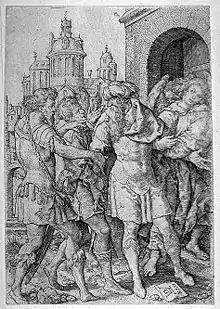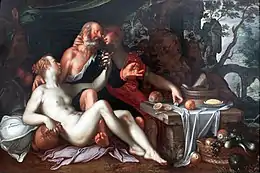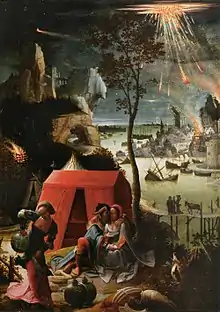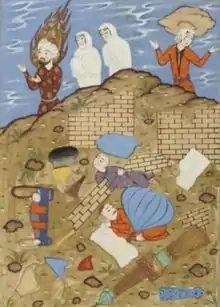Lot (biblical person)
Lot (/lɒt/; Hebrew: לוֹט – Lōṭ, "veil" or "covering";[1] Greek: Λώτ – Lṓt; Arabic: لُوط – Lūṭ) was a patriarch in the biblical Book of Genesis, chapters 11–14 and 19. Notable events in his life include his journey with his uncle Abram (Abraham) and his flight from the destruction of Sodom and Gomorrah, during which Lot's wife became a pillar of salt, and Lot was made drunk by his daughters so that they could have children with him.[2]
| Lot | |
|---|---|
_-_Google_Art_Project.jpg.webp) The Flight of Lot and His Family from Sodom (after Rubens), by Jacob Jordaens, c. 1620 (National Museum of Western Art, Tokyo) | |
| In-universe information | |
| Family | Haran (father) |
| Spouse | Lot's wife |
| Significant other | his daughters |
| Children | more than two daughters |
| Relatives | Milcah (sister) Iscah (sister) Nahor (uncle) Abraham (uncle) Sarah (aunt) Terah (grandfather) |
| Birth place | Ur Kaśdim |
Biblical account
Lot's background
_-_Google_Art_Project.jpg.webp)
Lot and his father Haran were born and raised in Ur of the Chaldees (Genesis 11:28, 31) in the region of Sumeria on the River Euphrates of lower Mesopotamia.[3] Haran died in that land before his father Terah. (Genesis 11:28)
Genesis 11:26–32 gives the "generations of Terah", Lot's grandfather, who arranged for their large family to set a course for Canaan where they could reestablish a new home. Among the family members that Lot travelled with, was his uncle Abram, (later called Abraham), one of the three patriarchs of Israel.
En route to Canaan, the family stopped in the Paddan Aram region, about halfway along the Fertile Crescent between Mesopotamia and the Mediterranean.[3] They settled at the site called Haran where Lot's grandfather, Terah, lived the rest of his days. He was 205 years old when he died. (Genesis 11:32)
Genesis 12 reveals Abram's obedience to the Lord at the age of 75, in continuing his journey to the land of promise. After his grandfather Terah died in Haran, Lot joined Abram on his journey to Chanan. There is no mention of Lot's having a wife yet. They went southwestward[4] into the land of Canaan, to the place of Sichem,[v. 5–6] the present day West Bank of Nablus.[4] Later they travelled south to the hills between Bethel and Hai,[v. 8] before journeying further toward the south of Canaan.[v. 9]
After they dwelt in the land of Canaan for a little while, a famine overtook the countryside, and they journeyed many miles farther south into Egypt.[v. 10–20] After having dwelt in Egypt for some time, they acquired vast amounts of wealth and numbers of livestock and returned to the Bethel area.[Gen.13:1–5]
Lot in the plain of Jordan
.jpg.webp)
Genesis 13 helps and discusses Abram and Lot's return to Canaan after the famine had passed and the lands became fertile again. They traveled back through the Negev to the hills of Bethel.[v. 1, 3] With their constant movement and the sizeable numbers of livestock each family owned requiring pasture, the herdsmen of the two groups began to bicker.[v. 6–7] These arguments became so troublesome that Abram suggested to Lot that they part ways, lest conflict continue among the "brethren".[v. 8–9]
Although Abram gave Lot the choice of going either north (the left hand) or south (the right hand), Lot instead looked beyond Jordan toward a well-irrigated plain and chose that land, for it seemed "like the garden of the LORD". Alas, ahead Lot could not foresee the destruction of Sodom and Gomorrah and the transformation of the water into a saline sea. (Genesis 13:9–11) Abram then headed south to Hebron, staying within the land of Canaan. (Genesis 13:12, 18)
Lot camped among the cities of the green Jordan plain and initially pitched his tent facing Sodom. Eight or so years[5] before, the five kingdoms had become vassal states of an alliance of four eastern kingdoms under the leadership of Chedorlaomer, king of Elam. They served this king for twelve years, but "the thirteenth year they rebelled." (Genesis 14:1–4) The following year Chedorlaomer's four armies returned and at the Battle of the Vale of Siddim, the kings of Sodom and Gomorrah fell in defeat.[v. 5–10] Chedorlaomer despoiled the cities and took captives as he departed, including Lot, who by then "dwelt" in Sodom.[v. 11–12]
When Abram heard what had happened to his "brother" Lot, he armed a rescue force of three hundred and eighteen of his trained servants and caught up to the armies of the four kings in the territory of the Tribe of Dan.[v. 13–14] Abram divided his forces, which attacked at night from multiple directions, and the four kings fled northeast. Abram's pursuit continued and the "slaughter of Chedorlaomer" and the other kings was completed at Hobah, north of Damascus. Abram brought back "his brother Lot" and all the people and their belongings. (v. 15–24)
Lot flees Sodom

Twenty four years after Abram and Lot began their sojourning, God changed Abram's name to Abraham, and gave him the covenant of circumcision.[Genesis 17] Not long afterward, "the LORD appeared" to Abraham in the form of "three men" come to visit and have a meal with him, and after two left to go to Sodom, "Abraham stood yet before the LORD."[Gen.18:1–22] Abraham boldly pleaded on behalf of the people of Sodom, where Lot dwelt, and obtained assurance the city would not be destroyed if fifty righteous people were found there. He continued inquiring, reducing the minimum number for sparing the city to forty five, forty, thirty, twenty, and finally, ten.[18:23–33]
Genesis 19:1 And there came two angels to Sodom at even; and Lot sat in the gate of Sodom: and Lot seeing them rose up to meet them; and he bowed himself with his face toward the ground;
2 And he said, Behold now, my lords, turn in, I pray you, into your servant's house, and tarry all night, and wash your feet, and ye shall rise up early, and go on your ways. And they said, Nay; but we will abide in the street all night.
3 And he pressed upon them greatly; and they turned in unto him, and entered into his house; and he made them a feast, and did bake unleavened bread, and they did eat.
After supper that night before bedtime, the men of the city, young and old, gathered around Lot's house demanding he bring his two guests out that they might "know" them. Lot went out and closed the door behind him and prayed that they not do such wicked things, and offered them his virgin daughters, that had not "known" man, that they might know them instead, and do with as they pleased. His response infuriated the men of Sodom who accused him of being judgmental and they threatened to do worse to him than they would have done to the men.[Gen.19:4–9]

Before they could harm Lot and break into the house, the men pulled Lot back in and struck the intruders with blindness, and revealed to Lot that they were angels sent to destroy the place. This allowed a window of opportunity for Lot to make preparations for him and his family to leave. When he went out to the men that were engaged to marry his daughters, warning them to flee, they assumed he was joking.[Gen.19:10–14]
As the day began to dawn, the angels urged him to hurry up and leave; when he lingered, the angels took hold of Lot, his wife and two daughters, and transported them beyond the city and set them down. The angel told Lot, "Escape for thy life; look not behind thee, neither stay thou in all the plain; escape to the mountain, lest thou be consumed."[Gen.19:15–17] Lot argued that if he went to the mountain some evil would cause his death, and he requested to be allowed to flee instead to the "little" city which was closer. (This city of Bela was later called Zoar because it was little.) His request was accepted, and they headed for Zoar instead.[Gen.19:18–22]

Genesis 19:23 The sun was risen upon the earth when Lot entered into Zoar.
24 Then the LORD rained upon Sodom and upon Gomorrah brimstone and fire from the LORD out of heaven;
25 And he overthrew those cities, and all the plain, and all the inhabitants of the cities, and that which grew upon the ground.
26 But his wife looked back from behind him, and she became a pillar of salt.
Abraham could see the smoke billowing upward from the countryside.[v. 27–28]
Instead of both fire and brimstone, Josephus has only lightning as the cause of the fire that destroyed Sodom: "God then cast a thunderbolt upon the city, and set it on fire, with its inhabitants; and laid waste the country with the like burning, as I formerly said when I wrote The Jewish War."[6]
Lot and his daughters


The account of Lot and his daughters is in Genesis 19:30–38
Genesis 19:30 And Lot went up out of Zoar, and dwelt in the mountain, and his two daughters with him; for he feared to dwell in Zoar: and he dwelt in a cave, he and his two daughters.
31 And the firstborn said unto the younger, Our father is old, and there is not a man in the earth to come in unto us after the manner of all the earth:
32 Come, let us make our father drink wine, and we will lie with him, that we may preserve seed of our father.
33 And they made their father drink wine that night: and the firstborn went in, and lay with her father; and he perceived not when she lay down, nor when she arose.
34 And it came to pass on the morrow, that the firstborn said unto the younger, Behold, I lay yesternight with my father: let us make him drink wine this night also; and go thou in, and lie with him, that we may preserve seed of our father.
35 And they made their father drink wine that night also: and the younger arose, and lay with him; and he perceived not when she lay down, nor when she arose.
36 Thus were both the daughters of Lot with child by their father.
The older daughter conceived Moab (Hebrew מוֹאָב, lit., "from the father" [meh-Av]), father of the Moabites;[v. 37] the younger conceived Ben-Ammi (Hebrew בֶּן-עַמִּי, lit., "Son of my people"), father of the Ammonites.[v. 38]
The story, usually called Lot and his daughters, has been the subject of many paintings over the centuries, and became one of the subjects in the Power of Women group of subjects, warning men against the dangers of succumbing to the temptations of women, while also providing an opportunity for an erotic depiction. The scene generally shows Lot and his daughters eating and drinking in their mountain refuge. Often the background contains a small figure of Lot's wife, and in the distance, a burning city.[7]
Family tree


| Terah | |||||||||||||||||||||||||||||||||||||||||||||||||||||||||
| Sarah[8] | Abraham | Hagar | Haran | ||||||||||||||||||||||||||||||||||||||||||||||||||||||
| Nahor | |||||||||||||||||||||||||||||||||||||||||||||||||||||||||
| Ishmael | Milcah | Lot | Iscah | ||||||||||||||||||||||||||||||||||||||||||||||||||||||
| Ishmaelites | 7 sons[9] | Bethuel | 1st daughter | 2nd daughter | |||||||||||||||||||||||||||||||||||||||||||||||||||||
| Isaac | Rebecca | Laban | Moabites | Ammonites | |||||||||||||||||||||||||||||||||||||||||||||||||||||
| Esau | Jacob | Rachel | |||||||||||||||||||||||||||||||||||||||||||||||||||||||
| Bilhah | |||||||||||||||||||||||||||||||||||||||||||||||||||||||||
| Edomites | Zilpah | ||||||||||||||||||||||||||||||||||||||||||||||||||||||||
| Leah | |||||||||||||||||||||||||||||||||||||||||||||||||||||||||
| 1. Reuben 2. Simeon 3. Levi 4. Judah 9. Issachar 10. Zebulun Dinah (daughter) | 7. Gad 8. Asher | 5. Dan 6. Naphtali | 11. Joseph 12. Benjamin | ||||||||||||||||||||||||||||||||||||||||||||||||||||||
Religious views

Jewish view
In the Bereshith of the Torah, Lot is first mentioned at the end of the weekly reading portion, Parashat Noach. The weekly reading portions that follow, concerning all of the accounts of Lot's life, are read in the Parashat Lekh Lekha and Parashat Vayera. In the Midrash, a number of additional stories concerning Lot are present, not found in the Tanakh, as follows:
- Abraham took care of Lot after Haran was burned in a gigantic fire in which Nimrod, King of Babylon, tried to kill Abraham.
- While in Egypt, the midrash gives Lot much credit because, despite his desire for wealth, he did not inform Pharaoh of Sarah's secret, that she was Abraham's wife.
- According to the Book of Jasher, Paltith, one of Lot's daughters, was burnt alive (in some versions, on a pyre) for giving a poor man bread.[10] Her cries went to the heavens.[11]
- Book of Ruth:The reference to Moab raises questions, since in the rest of the biblical literature it is associated with hostility to Israel, sexual perversity, and idolatry, and Deuteronomy 23:3–6 excluded an Ammonite or a Moabite from "the congregation of the LORD; even to their tenth generation".[12] Despite this, Ruth the Moabite married a Judahite and even after his death still regarded herself a member of his family; she then married another Judahite and bore him a son who became an ancestor of David.[13] Contrary to the message of Ezra–Nehemiah, where marriages between Jewish men and non-Jewish women were broken up, Ruth teaches that foreigners who convert to Judaism can become good Jews, foreign wives can become exemplary followers of Jewish law, and there is no reason to exclude them or their offspring from the community.[13]
- The fact that Rehoboam, the son of King Solomon, was born of an Ammonite woman (I Kings, xiv. 21–31) also made it difficult to maintain the Messianic claims of the house of David; but it was adduced as an illustration of divine Providence which selected the "two doves," Ruth, the Moabite, and Naamah, the Ammonitess, for honorable distinction (B. Ḳ. 38b).[14] Ruth's kindness as noted in the Book of Ruth by Boaz is seen in the Jewish Tradition as in rare contradistinction to the peoples of Moab (where Ruth comes from) and Amon in general, who were noted by the Torah for their distinct lack of kindness. Deut. 23:5: "Because they [the peoples of Amon and Moab] did not greet you with bread and water on the way when you left Egypt, and because he [the people of Moab] hired Balaam the son of Beor from Pethor in Aram Naharaim against you, to curse you." Rashi notes regarding Israel's travels on the way: "when you were in [a state of] extreme exhaustion."
- King Jehoash of Judah: Joash was one of the four men who pretended to be gods. He was persuaded thereto particularly by the princes, who said to him. "Wert thou not a god thou couldst not come out alive from the Holy of Holies" (Ex R. viii. 3). He was assassinated by two of his servants, one of whom was the son of an Ammonite woman and the other the offspring of a Moabite (2 Chron. 24:26); for God said: "Let the descendants of the two ungrateful families chastise the ungrateful Joash" (Yalk., Ex. 262). Moab and Ammon were the two offspring of Lot's incest with his two daughters as described in Gen. 19:30–38.
Christian view
In the Christian New Testament, Lot is considered sympathetically, as a man who regretted his choice to live in Sodom, where he "vexed his righteous soul from day to day" (2 Peter 2:6–9). Jesus spoke of future judgment coming suddenly as in the days of Lot, and warned solemnly, "Remember Lot's wife". (Luke 17:28–33)
Islamic view

Lut (Arabic: لُوط – Lūṭ) in the Quran is considered to be the same as Lot in the Hebrew Bible. He is considered to be a messenger of God and a prophet of God.[15]
In Islamic tradition, Lut lived in Ur and was a nephew of Ibrahim (Abraham). He migrated with Ibrahim to Canaan and was commissioned as a prophet to the cities of Sodom and Gomorrah.[16] His story is used as a reference by Muslims to demonstrate God's disapproval of homosexuality. He was commanded by Allah to go to the land of Sodom and Gomorrah to preach monotheism and to stop them from their lustful and violent acts. Lut's messages were ignored by the inhabitants, prompting Sodom and Gomorrah's destruction. Though Lut left the city, his wife was asked to be left behind by angels hence died during the destruction.[16] The Quran defines Lot as a prophet, and holds that all prophets were examples of moral and spiritual rectitude. The Quran does not include stories of Lot's drunkenness and/or incest. All Muslims reject the story of Prophet Lot having sex with his daughters.
Modern views

The presumptive incest between Lot and his daughters has raised many questions, debates, and theories as to what the real motives were, who really was at fault, and the level of bias the author of Genesis Chapter 19 had. However, such biblical scholars as Jacob Milgrom,[18] Victor P. Hamilton,[19] and Calum Carmichael[20] postulate that the Levitical laws could not have been developed the way they were, without controversial issues surrounding the patriarchs of Israel, especially regarding incest. Carmichael even attributes the entire formulation of the Levitical laws to the lives of the founding fathers of the nation, including the righteous Lot (together with Abraham, Jacob, Judah, Moses, and David), who were outstanding figures in Israelite tradition.
According to the scholars mentioned above, the patriarchs of Israel are the key to understanding how the priestly laws concerning incest developed. Kinship marriages amongst the patriarchs include Abraham's marriage to his half-sister Sarai;[Gen.20:11–12] the marriage of Abraham's brother, Nahor, to their niece Milcah;[Gen.11:27–29] Isaac's marriage to Rebekah, his first cousin once removed;[Gen.27:42–43; 29:10] Jacob's marriages with two sisters who are his first cousins;[Gen.29:10, Ch.29] and, in the instance of Moses's parents, a marriage between nephew and aunt (father's sister).[Exod.6:20] Therefore, the patriarchal marriages surely mattered to lawgivers and they suggest a narrative basis for the laws of Leviticus, chapters 18 and 20.[21]
The Levitical laws against incest were created, it has been argued, to separate the lifestyle of the Israelite from the lifestyle of the people of Canaan,[Gen.9:22–28] despite any incestual involvements the patriarchs had had in the past.[22] The Levitical laws were needed for a developing nation who needed to be seen as different from the world, cleansed and blameless: The first step starting with circumcision.[Gen.17:1, 10; Ch.17] So nothing could be held against the patriarchs for incestuous behavior because this was part of progressive development, from the ways of the world (coming out of Chaldea) to becoming blameless before their God.[Gen.17:1][22]
Some have argued that Lot's behavior in offering of his daughters to the men of Sodom in Genesis 19:8 constitutes sexual abuse of his daughters, which created a confusion of kinship roles that was ultimately played out through the incestuous acts in Genesis 19:30–38.[23]
A number of commentators describe the actions of Lot's daughters as rape. Esther Fuchs suggests that the text presents Lot's daughters as the "initiators and perpetrators of the incestuous 'rape'."[24]
See also
- Bani Na'im
- Biblical narratives and the Qur'an
- Lekh-lekha
- Vayeira
- Baucis and Philemon
References
- "H3876 לוט – Lot (lote)". Strong's Hebrew Lexicon. studybible.info.
- Mirabeau, Honoré (1867). Erotika Biblion. Chevalier de Pierrugues. Chez tous les Libraries.
- Drummond, Dorothy Weitz, 2004, Holy land, whose land?: modern dilemma, ancient roots, p. 75
- Drummond, Dorothy Weitz, 2004, Holy land, whose land?: modern dilemma, ancient roots, p. 76
- Years reckoned by comparing Bible marginal (Ussher) dates: Lot's move to Sodom area margin BC 1918. Battle of Siddim margin BC 1913, the 14th year, making 1926 the first of the fourteen and 1926-1918=8 years before Lot moved there.
- Flavius Josephus, Antiquities, Book 1, Chapter 11, Section 4, Sentence 3 Archived 16 December 2009 at the Wayback Machine. Also:
"It is related how, for the impiety of its inhabitants, it was burnt by lightning; in consequence of which there are still the remainders of that Divine fire" Josephus, Wars Book 4, Chapter 8, Section 4 - Lowenthal, Anne W. (1988), "Lot and His daughters as Moral Dilemma", in The Age of Rembrandt: Studies in Seventeenth-century Dutch Painting, Volume 3 of Papers in Art History from the Pennsylvania State University, eds. Roland E. Fleischer, Susan Scott Munshower, 1988, Penn State Press, ISBN 0915773023, ISBN 978-0915773022, google books
- Genesis 20:12: Sarah was the half–sister of Abraham.
- Genesis 22:21-22: Uz, Buz, Kemuel, Chesed, Hazo, Pildash, and Jidlaph
- Jewish encyclopedia Lot
- Chabad.com
- West 2003, p. 209.
- Grabbe 2004, p. 312.
- Jewish encyclopedia Ammonites
- Quran 26:161
- Hasan, Masudul (1987). History of Islam, Volume 1. Islamic Publications. p. 26. Retrieved 9 July 2012. Quote: Lut was a nephew of the Prophet Abraham. He migrated with Abraham from Iraq to Canaan in Palestine. He was commissioned as a prophet to the cities of Sodom and Gomarrah, situated to the east of the Dead Sea. The people of these cities were guilty of unspeakable crimes. They were addicted to homosexuality and highway robberies. Lut warned the people but they refused to listen to him. He prayed to Allah to punish the people. Lot left the city with his followers at night. As soon as he left, Allah raised a [shower of brim stones?]-end quote, text garbled.
- "Artemisia Gentileschi"; Mary D Garrard; Rizzoli Art Series, 1993. ISBN 0-8478-1652-4
"The seduction of Lot became a popular topic in Baroque Art: if in general the women are portrayed as seductresses and the mood as ribald, the female artist Artemisia Gentileschi's portrait diverges sharply, showing the women fully clothed and the mood as solemn." - Milgrom. Leviticus 17–22, 1515–1520
- Victor P. Hamilton. The Book of Genesis Chapters 18–50
- Carmichael. Legend and Incest
- Johnson M. Kimuhu. Leviticus: the priestly laws and prohibitions from the perspective of ancient Near East and Africa, Studies in biblical literature: Volume 115, 2008. pp. 31–33
- Kimuhu. Leviticus Studies, Vol. 115, 2008. p. 31
- Katherine B. Low (Fall 2010). "The Sexual Abuse of Lot's Daughters: Reconceptualizing Kinship for the Sake of Our Daughters". Journal of Feminist Studies in Religion. Indiana University Press. 26 (2): 37–54. doi:10.2979/fsr.2010.26.2.37. S2CID 143666743.
- Fuchs, Esther (2003). Sexual Politics in the Biblical Narrative: Reading the Hebrew Bible as a Woman. p. 209. ISBN 9780567042873. Retrieved 10 July 2015.
Bibliography
- Calmet, Augustin (1832). Calmet's Dictionary of the Holy Bible. Boston: Crocker & Brewster. p. 737. LCC BS440.C3. Retrieved 9 July 2012.
- Grabbe, Lester L. (2004). The History of the Jews and Judaism in the Second Temple Period, Volume 1: Yehud, the Persian Province of Judah. Continuum. pp. 105 & 312. ISBN 9780567089984.
- West, Gerald (2003). "Ruth". In Dunn, James D.G.; Rogerson, John William (eds.). Eerdmans Commentary on the Bible. Eerdmans. ISBN 9780802837110.
External links
| Wikimedia Commons has media related to Lot (Bible). |
| Look up Lot in Wiktionary, the free dictionary. |
- Our People: A History of the Jews – Abram and Lot at chabad.org
- . Encyclopædia Britannica (11th ed.). 1911.
- . Easton's Bible Dictionary. 1897.